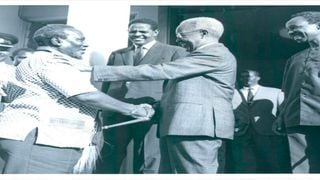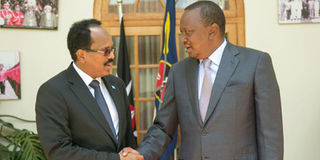
President Jomo Kenyatta (left) shakes hands with Somalia President Aden Abdulle Osman in Arusha, Tanzania when they met to discuss the Kenya-Somalia border dispute. Looking on are Somalia's Prime Minister Abdikirizak Haji Hussein (centre) and Tanzania's President Julius Nyerere.
| File | Nation Media GroupNews
Premium
How Jomo Kenyatta stopped a wily British attempt to dismember Kenya
What you need to know:
- The maritime dispute is not the first time Kenya and Somalia are squabbling over borders.
- Jomo Kenyatta refused to cede any part of Kenya to Somalia and it seems his son will follow suit.
President Uhuru Kenyatta perhaps knows this story better than I do. It could be one of those fireside stories he heard from his father while growing up in Ichaweri – and it is about the Somalia border question.
He is now facing a political and legal dilemma over the maritime boundary with Somalia a week after the International Court of Justice decided to redraw the border.
Had Jomo Kenyatta agreed with a British delegation sent to collect views on the future of the Northern Frontier District (NFD), River Tana would have formed the natural boundary with Somalia, and Garissa would have been a border town. Both Wajir and Mandera would be in the interior of Somalia.
On the afternoon of November 21, 1962, this British delegation went to see Jomo to hear his views on the bid by the Northern Frontier District to secede to form a greater Somalia ahead of Kenya’s independence. The country was about to lose a third of its land, though some London blatherskites tried to convince Mzee that the land was a desert and of no use to him. He refused to buy that line.
Kenyatta – who was flanked by Tom Mboya – told the delegation, appointed by Secretary of State for the Colonies Duncan Sandys, that he strongly supported the retention of NFD as part of Kenya, arguing that there were many Kanu supporters in the NFD and he had a right to speak for them.
Again, he said, the Somali community were not the only tribes divided by the colonial boundaries and if African nations opened that window, there will be no end in sight in drawing African boundaries. Scholars of colonial cartography know this well.
Two months earlier, in London, Jomo had told a press conference that September that “Kenya will not give an inch” of its soil to Somalia, which was seeking to expand its territory to the west.
Jomo was getting irritated: “Our point has been clearly put. They have no right to the North Frontier District.”
Thus, on top of the headache of having a unitary state – the position taken by Kanu – Jomo was now dealing with Somalia’s bid to annex part of Kenya.
Drums of war
“It is for them to adapt themselves to the new conditions. NFD is ours,” Jomo told the press with some finality.
It is that finality that took the day. Had Jomo not resisted, and this is simply a historical counterfactual argument, it is likely that the NFD would have seceded from Kenya. Why do I think so?
The appointment of a commission to look into the question and to hold a public rally referendum on the question was the first attempt to sanitise the British move.
The terms of reference for that delegation, led by Nigerian lawyer G.C. M. Onyiuke, were telling: “To ascertain, and report on, public opinion in the Northern Frontier District comprising Isiolo, Garissa, Mandera, Marsabit, Moyale and Wajir regarding arrangements to be made for the future of the area in the light of the likely course of constitutional development in Kenya.”
Kanu was opposed to the idea of holding public rallies organised by secessionists to gauge the feelings on the ground. Again, NFD was still a closed district.
That Britain was favouring the autonomy of regions, in the hope that this would give white settlers a chance to manoeuvre within the White Highlands was well known. They were also tacitly supporting Kadu’s majimbo and opposed to Kenyatta’s call for a unitary state.
From 1961 drums of war were sounding and local chiefs had been warning that Kenya would witness bloodshed – or what they called “another Congo in Kenya” – if they did not have their way.
Since 1902, the region was treated as a closed district, and as Jomo told the delegates, there was no plebiscite that could be conducted there in open meetings and where Kanu was not allowed to go and articulate its stand. In their report, the commissioners stated that they found that there were areas in the NFD supporting Somali opinion, while some areas were supporting Kenya opinion. Some were uncertain.
Secessionist bid
In order to balance all the interests, and wary that the Somali question could unite both Kanu and Kadu and create a crisis, the British government decided to form a seventh region in the area.
It is a position that was taken by Kanu when in September 1963, just before the final Lancaster Conference kicked off, the party’s executive officer Mwai Kibaki called a press conference to restate the party’s position.
“Any individual persons who want to leave Kenya and go to live in Somalia or any other neighbouring countries have always been absolutely free to do so. What we will not allow is the dismemberment of Kenya,” he said.
But to push their case, the NFD region not only boycotted the 1963 elections for regional assemblies, they also had all the 34 chiefs resign en masse and, embarrassingly, on the day that Governor Malcolm MacDonald had flown to Wajir to meet them. Meanwhile, the Somali government had continued to relay broadcast propaganda in songs and poems encouraging the NFD region to join Somalia.
Tension was building as Kenya raced towards independence without a solution to the NFD question. Then, Jomo warned that some assassins had been hired to kill moderate NFD administrators.
And it came to pass when on June 28, 1963 Isiolo District Commissioner Daudi Wabera’s convoy was ambushed near Modo Gashe. He was killed on the spot together with Senior Chief Galma Dida. The assassins then escaped to Somalia and the government in Mogadishu refused to hand them over.
Though Somalia no longer claims that part of Kenya and the secessionist bid left the area in social and economic turmoil, it now appears that we still have unresolved border wars with Somalia – and the latest is the tussle over the maritime border which has put Jomo’s son in the same border dilemma he faced 60 years ago.

President Uhuru Kenyatta with Somalia President Mohamed Abdullahi Mohamed at State House, Nairobi on March 23, 2017.
President Kenyatta, perhaps borrowing from his father, has said that he, too, will not hand over Kenyan waters to Somalia.
Actually, had the British government not given Jubaland district to the Italians in 1925, that contentious line would have been further north. The current row has everything to do with the way Jubaland was curved. Let me repeat a story I have written here before.
We know from records that when World War I broke, Italy signed a secret treaty with Britain and was asked to abandon its former allies to join Britain, France and Russia. For that, Italy had been promised under Article 13 of the Treaty of London that once Germany was defeated by the allies, Great Britain would cede part of its Kenyan colony at Jubaland to it.
In the same agreement, Italy’s sovereignty over the Dodecaneso Islands in Greece was to be fully recognised and there would be a revision of the frontiers of Italian colonies in Africa, where they bordered either French or British colonies. This meant that the size of Italian colonies in Africa would be increased.
But after the war, Britain refused to cede Jubaland, arguing that Italian leader Benito Musolini should hand over Dodecaneso Islands to Greece first. When Lord Curzon, the British Foreign Secretary, made the cession of Jubaland a new condition to settling the Dodecanese question, Musolini wrote a note to the United Kingdom describing Jubaland as a “dent of honour which England could not repudiate without breaking her word”.
This was discussed in the British Parliament, with one MP describing Jubaland as a “debt of honour” that has to be repaid. After Lord Curzon left his position after the November 1922 election and a new Labour government came into office, and despite their opposition to Fascism, the new Prime Minister and Foreign Secretary Ramsay MacDonald decided to appease Mussolini by ceding Jubaland – or what they thought was a cheap concession.
Had Kenya approached the case from a historical perspective, the ICJ drama would have been less. We could have looked at the diplomatic haggling between Musolini and Britain and found the answer in there.
As Martin Clark, the Mussolini biographer wrote: “Jubaland was not worth having. It was the first of what Mussolini later called his ‘collection of deserts’ but it was, undeniably, a colonial territory in Africa. It had not been won by conquest nor, needless to say, out of any regard to its inhabitants’ wishes, but by old-fashioned diplomatic haggling.”
And there, perhaps, lies the answer to the maritime boundary row – but only if we are willing to dig deeper. But then, maritime boundaries are a new concept. And that is President Kenyatta’s headache. Our headache.
Will Uhuru resist like Jomo?
[email protected]; @johnkamau1





